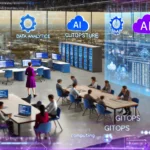It is really a fascinating thing to know how does Artificial Intelligence work. Artificial intelligence (AI) has emerged as a groundbreaking technology that seeks to replicate human intelligence in machines. It has become increasingly prevalent across numerous industries, revolutionizing the way we live and work. From healthcare and finance to transportation and entertainment, AI is making a profound impact and driving significant advancements.
In this blog post, we will explore the inner workings of artificial intelligence, unraveling its core concepts and shedding light on its practical applications. We will delve into the fascinating world of AI algorithms, machine learning, deep learning, natural language processing, computer vision, and the integration of AI with robotics. By the end, you’ll have a clearer understanding of how AI functions and its potential to reshape our future.
Join us as we embark on this journey to demystify artificial intelligence and discover the incredible possibilities it holds across various fields. Get ready to explore the fascinating realm of AI and unlock the secrets behind its remarkable capabilities.
What is Artificial Intelligence?
Artificial intelligence (AI) refers to the field of computer science that focuses on developing intelligent machines capable of performing tasks that typically require human intelligence.
The primary objective of AI is to replicate and mimic human intelligence, enabling machines to understand, reason, learn, and make decisions.
Differences Between General AI VS Narrow AI
AI can be classified into two main types: narrow AI and general AI. Narrow AI, also known as weak AI, is designed to excel at specific tasks or functions.
It operates within a limited domain and is proficient at tasks such as voice recognition, image classification, and language translation. Examples of narrow AI include virtual assistants like Siri and chatbots.
On the other hand, general AI aims to possess the same level of intelligence and versatility as humans across a broad range of tasks.
It involves creating machines that can understand, learn, and apply knowledge in various domains, similar to human cognition. General AI remains an ambitious goal and an area of ongoing research.
| Narrow AI | General AI | |
| Definition | AI designed for specific tasks within a limited domain | AI with the capability to perform tasks across various domains, exhibiting human-like cognition |
| Scope | Specialized and focused on specific applications | Broad and versatile, capable of adapting to new tasks and learning from various domains |
| Examples | Virtual assistants (Siri, Alexa), recommendation systems, chatbots | AI systems capable of reasoning, problem-solving, and performing tasks across different domains |
AI technologies and systems have become pervasive in our daily lives. From recommendation systems used by streaming platforms to personalized advertisements on social media, AI algorithms work behind the scenes to enhance user experiences.
Autonomous vehicles, smart home devices, and virtual assistants are other examples of AI technologies that have gained widespread adoption.
Through sophisticated algorithms, machine learning, and neural networks, AI can process massive amounts of data, identify patterns, and generate insights.
This enables AI systems to make predictions, recognize speech, interpret natural language, and even perform complex tasks like image recognition and autonomous navigation.
We will explore the intricacies of machine learning, deep learning, natural language processing, computer vision, and the integration of AI with robotics.
By understanding the underlying mechanisms of AI, we can appreciate the immense potential it holds for transforming various industries and shaping the future of technology.
Machine Learning: The Core of AI & The Answer to How Does Artificial Intelligence Work
Machine learning plays a pivotal role in the field of artificial intelligence (AI) by enabling machines to learn from data and improve their performance over time. It is a subset of AI that focuses on developing algorithms and models that can automatically learn and make predictions or decisions without explicit programming.
The significance of machine learning in AI lies in its ability to analyze large volumes of data, identify patterns, and make informed predictions or decisions. By leveraging statistical techniques and computational power, machine learning algorithms can uncover valuable insights and automate complex tasks.
There are three main types of machine learning algorithms: supervised learning, unsupervised learning, and reinforcement learning.

Supervised Learning
Supervised learning involves training a model using labeled data, where the desired output is known. The algorithm learns to map inputs to outputs by generalizing from the provided examples. It is widely used in tasks such as classification, regression, and prediction. For example, in image recognition, a supervised learning algorithm can be trained on labeled images to classify new, unlabeled images accurately.
Unsupervised Learning
Unsupervised learning operates on unlabeled data, seeking to identify patterns or structures within the data without any predefined outputs. Clustering and dimensionality reduction are common applications of unsupervised learning. By analyzing the inherent structure of the data, unsupervised learning algorithms can group similar data points together or reduce the complexity of the data representation.
Reinforcement Learning
Reinforcement learning involves an agent that interacts with an environment, learning to make decisions and take actions to maximize a reward signal. Through a trial-and-error process, the agent learns which actions lead to desirable outcomes and receives feedback in the form of rewards or penalties. Reinforcement learning has been successful in training autonomous agents, playing games, and optimizing complex systems.
Machine learning finds extensive application across various industries. In image recognition, machine learning algorithms can accurately identify objects, faces, and scenes in photographs or videos.
Natural Language Processing (NLP)
Natural language processing (NLP) utilizes machine learning to understand and process human language, enabling tasks like sentiment analysis, language translation, and chatbot interactions.
Moreover, machine learning plays a crucial role in recommendation systems, where algorithms learn from user preferences to suggest personalized products or content. Fraud detection in financial transactions, predictive maintenance in manufacturing, and healthcare diagnosis are other real-world applications where machine learning shines.
By harnessing the power of machine learning, AI systems can continuously learn and adapt to new data, improving their performance and decision-making capabilities. As machine learning techniques advance and more data becomes available, the potential for AI to drive innovation and solve complex problems continues to expand.
Deep Learning: Unleashing the Power of Neural Networks
Deep learning, a subset of machine learning, unleashes the power of neural networks to tackle complex tasks. Neural networks are inspired by the structure and functioning of the human brain, consisting of interconnected layers of artificial neurons.
These networks excel at recognizing patterns and extracting features from vast amounts of data. In deep learning, multiple layers enable hierarchical representation learning, empowering the network to automatically learn complex representations. You can gather more knowledge by learning how can Deep Learning models be trained.
Deep learning has made significant advancements in tasks like speech recognition, where models can transcribe spoken language with remarkable accuracy. It has also revolutionized autonomous driving by enabling vehicles to perceive their surroundings, make decisions, and navigate safely.
Neural networks, with their ability to process large amounts of data and capture intricate relationships, have become the driving force behind the success of deep learning in addressing challenging problems across various domains.
Natural Language Processing: Understanding Human Language
Natural Language Processing (NLP) is a branch of artificial intelligence (AI) that focuses on the interaction between computers and human language. It enables machines to understand, interpret, and generate human language, bridging the gap between human communication and computational systems.
NLP plays a crucial role in AI by enabling machines to process and comprehend natural language text or speech. It involves various techniques, such as text classification, sentiment analysis, machine translation, and information extraction, to extract meaning and insights from textual data.
Text classification algorithms categorize text into predefined categories, aiding tasks like spam detection, topic classification, and sentiment analysis. Sentiment analysis helps machines identify the emotional tone in text, allowing businesses to understand customer opinions and gauge public sentiment towards products or services. These applications of natural language processing (NLP) assist in streamlining processes and gaining insights from textual data.
Machine translation is another important application of NLP, enabling the automatic translation of text from one language to another. It has contributed to breaking down language barriers and facilitating global communication.
The impact of NLP extends to virtual assistants and chatbots, where it enables natural language understanding and generation. Virtual assistants like Siri, Alexa, or Google Assistant utilize NLP techniques to interpret user queries, provide relevant information, and execute tasks based on voice commands. Chatbots, employed in customer support or online messaging services, rely on NLP to understand user input and provide automated responses in a conversational manner.
Computer Vision: Seeing the World Through AI Eyes
Computer vision, a field of AI, focuses on enabling machines to see and understand visual information. It involves developing algorithms and models for image and object recognition. Computer vision finds applications in various domains, including medical imaging and the development of autonomous robots. By leveraging computer vision, AI systems gain the ability to perceive and interpret the visual world around them.
Robotics and AI: The Future of Automation
The integration of AI and robotics is reshaping the future of automation. AI enables robots to perform complex tasks by leveraging algorithms, machine learning, and computer vision. By learning from their environment, AI-powered robots adapt and improve their performance. Industries like manufacturing and healthcare are experiencing the transformative impact of AI-powered robots, enhancing efficiency and productivity.

Ethical Considerations and Challenges in AI
The widespread adoption of artificial intelligence (AI) has raised important ethical considerations that need to be addressed. As AI technologies become more pervasive, several key concerns have emerged.
One significant ethical implication of AI is related to privacy. AI systems often rely on collecting and analyzing large amounts of data, raising concerns about data security and the potential misuse of personal information. Safeguarding privacy rights and implementing robust data protection measures are essential in ensuring responsible AI development.
Another concern is the potential for job displacement. As AI and automation technologies advance, certain tasks traditionally performed by humans may be automated, potentially leading to job losses in certain sectors. It is crucial to consider strategies for reskilling and upskilling the workforce to ensure a smooth transition and create new employment opportunities.
Bias in AI algorithms
Bias in AI algorithms is another critical issue. AI systems are trained on data, and if the data contains biases, the algorithms may inadvertently perpetuate those biases. It is vital to address and mitigate bias in AI systems to ensure fairness and equity, particularly in areas like hiring, lending, and criminal justice.
Transparency is another key aspect of ethical AI. It is essential for AI algorithms and decision-making processes to be transparent and explainable. This enables users and stakeholders to understand the reasoning behind AI-driven decisions and helps build trust in the technology.
To tackle these ethical challenges, ongoing research and initiatives are being conducted to promote responsible AI development. Organizations are working on developing frameworks and guidelines for ethical AI, emphasizing principles such as transparency, fairness, and accountability. Regulatory efforts are also underway to ensure that AI technologies adhere to ethical standards and promote societal well-being.
Conclusion
Now we can say that we have learned how does Artificial Intelligence work. Artificial intelligence (AI) is a revolutionary field that aims to replicate human intelligence in machines. Through machine learning, deep learning, natural language processing, and computer vision, AI systems can understand, learn, and make decisions. AI has the potential to transform various industries, improve efficiency, and enhance decision-making. However, ethical considerations such as privacy, bias, and job displacement must be addressed. It is crucial for individuals to stay informed about AI advancements and actively engage in discussions to ensure responsible AI development. By embracing AI’s potential while being mindful of its implications, we can shape a future where AI benefits society as a whole.








